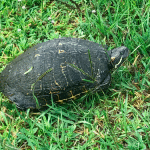When I was a kid, I used to drive my mom and sisters crazy asking them to stop every time I saw a turtle in the road. Back then, I wanted to bring them home to live in our backyard. These days, I still stop but now I just give them a lift across the road to help them on their way. I hate seeing smashed turtles on the road. It’s such a senseless way for them to die and so easily avoided. I’ve also learned a lot since I was a kid. I now know that turtle collection on roads seriously contributes to population declines in many species. Perhaps it’s my adult perspective but it seems to me that I don’t see nearly as many these days so I feel it is more important than ever to help them out.
Turtles are mostly seen crossing roads between March and November. The females are searching for the perfect spot to lay their eggs and the males are looking for mates and new territories. In this area, I primarily see Red-eared Sliders and Box Turtles but there are many others. Turtles are particularly vulnerable to both collection and road kill because they are typically slow moving and non-aggressive. Watch out for those snapping turtles though. They definitely know how to be aggressive if they feel threatened.
Believe it or not, there is a proper and improper way to help a turtle across the road. I’ve always heard you can safely pick up a snapping turtle by its tail but this is untrue. You should never pick up a turtle this way because you can injure it. Small turtles can be picked up by putting one hand on each side of the shell behind the front legs. Try to keep the turtle low to the ground when moving it because if it pushes free from your hands you don’t want it to fall very far. Larger turtles and especially snapping turtles should not be picked up. You can help them across the road by pushing them with a blunt object.
The final rule of helping turtles across the road is to always move the turtle in the direction it was going. If you turn it around, it will simply turn right back around and attempt to go across the road again after you are gone. Turtles are on a mission and they won’t take a hint from you about going back in the direction they came from. Also, although you may be tempted to relocate a turtle for its safety, this is not a good idea. Turtles have home ranges and if you move them somewhere else, they will attempt to return to the area they call home.
Turtles are slow to sexually mature, lay relatively few eggs, and mortality of eggs and hatchlings is usually pretty high. Add that to an ever increasingly fragmented habitat and you can see why turtle populations are in trouble. So next time you see a turtle in the road, give them a brake (yes I know I spelled that wrong – it’s a play on words!).
